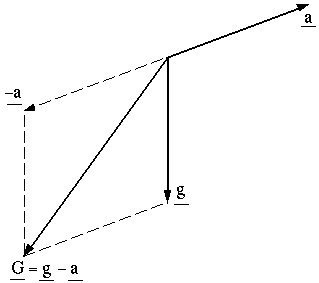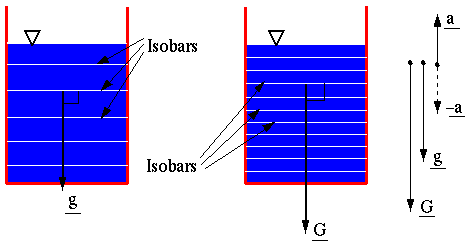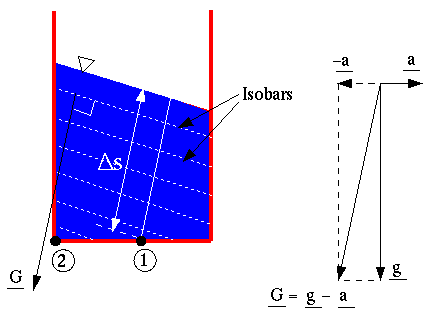Fluids in Rigid Body Motion
Introduction
- Recall, for the case of rigid body motion, the equation of
motion for fluid flow (the Navier-Stokes equation) reduces to

Note that a new "effective gravity" vector, G,
has been defined as the vector sum of gravity and the negative
of the acceleration vector. This new effective gravity vector
can be obtained with a little trigonometry as the resultant vector
of adding g and -a.

- There are two cases of rigid body motion to be discussed:
uniform linear rigid body acceleration, and rigid
body rotation.
Uniform Linear Rigid Body Acceleration
- Consider the case where the fluid is accelerated uniformly
in some direction. In other words, each fluid particle in the
container feels exactly the same acceleration vector, which is
constant in time. In such a case, since both the gravity vector
and the acceleration vector are constant, the effective gravity
vector, G, must also be constant.
- Notice, then, that the equation of motion is identical to
the hydrostatics equation, except that gravity g is replaced
by effective gravity G. This makes problems of this type
no more difficult than simple hydrostatics. In fact, for uniform
linear rigid body acceleration, the solution is identical to that
of hydrostatics, but with g replaced by G, and with
z (parallel to g, i.e. down) replaced by s (parallel to
G). A good way to remember this is to imagine that the
accelerating fluid is instead sitting on a planet where gravity
acts in some strange direction (that of vector G) and with
some magnitude G. One consequence of this is that isobars must
be perpendicular to G, i.e. perpendicular to direction
s. In fact, the pressure increases linearly with distance s, rather
than with z.

- As an example, consider a glass of water in an elevator which
is accelerating up:

Here, the effective gravity is still downward, but of greater
magnitude than g. The isobars are still horizontal surfaces as
in hydrostatics. In fact, everything is identical to hydrostatics
except for a larger gravity (pretend for example that the glass
is sitting on the planet Jupiter). Our simple hydrostatic pressure
relationship still applies, but with g replaced by G, and z replaced
by s, i.e.

Also note that "below" and "above" are relative
to coordinate s rather than z as well. All else being equal, the
pressure at the bottom of the accelerating glass will be greater
than that at the bottom of the stationary glass (because G is
greater than g).
- Now consider a glass of water in an elevator that accelerates
uniformly to the right. Again, the effective gravity vector can
be constructed as shown:

Now, since the effective gravity is tilted at some angle to the
lower left, the isobars must be perpendicular to this direction.
The isobars are thus titled down and to the right as sketched.
Note that the surface remains an isobar of constant pressure pa,
and is therefore also tilted as sketched. At some point 1 in the
fluid, the pressure can be found from the revised hydrostatic
pressure relationship as follows:

Rigid Body Rotation
- Consider a container of some liquid which is rotating about
a vertical axis at some constant angular velocity, as shown in
the sketch:

- For any kind of rigid body motion, the equation of motion
for fluid flow (the Navier-Stokes equation) reduces to
 In rigid body linear acceleration, effective gravity vector, G,
was constant everywhere in the fluid. Here, this is no longer
the case, since the acceleration of a fluid particle rotating
about some axis varies with distance from the axis. In fact, for
circular motion, the acceleration is always inward, towards the
center of rotation (centripetal acceleration). This acceleration
increases linearly with radius (see text for derivation):
In rigid body linear acceleration, effective gravity vector, G,
was constant everywhere in the fluid. Here, this is no longer
the case, since the acceleration of a fluid particle rotating
about some axis varies with distance from the axis. In fact, for
circular motion, the acceleration is always inward, towards the
center of rotation (centripetal acceleration). This acceleration
increases linearly with radius (see text for derivation):
 Thus, the effective gravity vector, G, is not constant,
but varies with radius. In the sketch below, the effective gravity
vector at point A is constructed:
Thus, the effective gravity vector, G, is not constant,
but varies with radius. In the sketch below, the effective gravity
vector at point A is constructed:
 Locally, the isobars near point
A are of course still perpendicular to G, and they are
shown.
Locally, the isobars near point
A are of course still perpendicular to G, and they are
shown.
- At other points in the flow, however, the local effective
gravity vector is different, since the local acceleration is different.
For example, at point B (at a bigger radius than point A) the
inward acceleration vector is larger, and G tilts further
to the right as sketched below:
 The local isobars around point B, being perpendicular to the local
effective gravity vector, are thus tilted to the upper right even
more severely than at point A. At the centerline (point C), the
local acceleration is zero, and the effective gravity is identical
to the standard gravity; isobars near the centerline of the rotating
liquid are horizontal, just as in hydrostatics:
The local isobars around point B, being perpendicular to the local
effective gravity vector, are thus tilted to the upper right even
more severely than at point A. At the centerline (point C), the
local acceleration is zero, and the effective gravity is identical
to the standard gravity; isobars near the centerline of the rotating
liquid are horizontal, just as in hydrostatics:

- If this kind of analysis is done everywhere in the flow, the
isobars turn out to be paraboloids, which are constructed by rotating
a parabola about its axis to generate an axisymmetric surface:
 The free surface is of course an isobar, since its pressure is
atmospheric. Pressure increases perpendicular to the isobars.
The free surface is of course an isobar, since its pressure is
atmospheric. Pressure increases perpendicular to the isobars.
- The text provides a more detailed mathematical derivation
of the equations for pressure and for the isobars. If the origin
is defined at the lowest point on the free surface, as shown in
the sketch above, the equations for pressure and for the isobars
are:

- When p = pa, the second equation above becomes
an equation describing the free surface. When p is greater than
pa, this equation describes isobars below the surface
(at higher pressure). Now denote h as the difference between the
height at the center of the free surface and the rim of the free
surface. It turns out that, compared to the original free surface
(container not rotating at all), the surface dips down at the
center an amount (h/2) equal to the amount the surface rises at
the rim (also h/2). This is illustrated below:

- Consider a numerical example. A container of water of radius
4.0 inches rotates at a fixed angular velocity of 100 rpm. Estimate
h:
 A simple experiment with a rotating cup of water can show that this prediction is quite accurate.
A simple experiment with a rotating cup of water can show that this prediction is quite accurate.
- Notice that density does not appear in the equation for the
isobars or in the equation for h. Thus, the water could be replaced
with any other liquid, and the result would be identical. Pressure
would increase more rapidly with depth for a denser liquid, but
the shape of the free surface would stay the same, regardless
of the liquid used. Furthermore, since this is rigid body rotation,
portions of the liquid could even be removed or replaced with
solid material. In this way, any rotating chunk of liquid, regardless
of its shape, can be analyzed as if it were part of a big container
rotating about the z-axis as in the figures above.
















